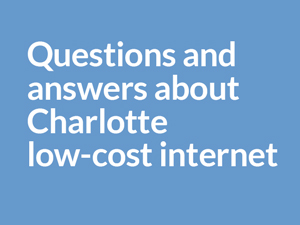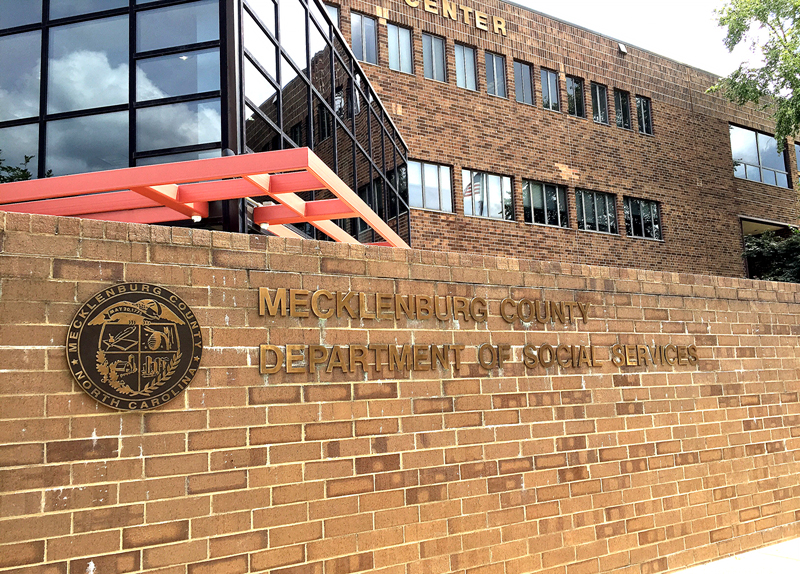Walk into the office where Mecklenburg County residents apply for food assistance and you will be immediately greeted by a wall of brochures with resources for low-income residents: medical services, nutritional needs, family counseling and more.
What a reporter could not find was information about an opportunity that could be a lifeline for those who are poor: low-cost access to the internet.
Mecklenburg’s largest internet service providers, AT&T and Spectrum, have such plans. But a team of student journalists from Queens University of Charlotte found weak awareness about them across Mecklenburg among low-income residents and some of the agencies that work with them. Nowhere was that lack of awareness more obvious than inside an office at Mecklenburg’s Department of Social Services, where people apply for benefits under the Supplemental Nutrition Assistance Program (SNAP).
Nowhere was that lack of awareness more obvious than inside an office at Mecklenburg’s Department of Social Services, where people apply for benefits under the Supplemental Nutrition Assistance Program (SNAP).
Residents who are approved for SNAP (the successor to food stamps) may qualify for AT&T’s low-cost plan, called AT&T Access. But people streaming in on the day that reporters visited said they had not heard about the offer of low-cost internet.
“I’m amazed nobody has heard about this,” said one SNAP applicant, Levoid Ratliff Jr. He said his friends didn’t know about the plans either. “Most people probably don’t know about this. Eight, nine out of ten,” Ratliff said.
Allison Williams, who assisted applicants at the counter, said she also was unaware of the programs and knew of no efforts to let people know about them.
Reporters found similar reactions at other agencies and institutions. They included a branch of the Charlotte-Mecklenburg Library that is often filled with low-income residents using its internet connections, and the Charlotte Housing Authority, which provides subsidized housing for 22,000 residents.
Spokesmen for Spectrum and AT&T said that they make efforts to get the word out. They would not disclose how many people they have enrolled in their programs. Spectrum’s plan is 21 months old. AT&T began offering its plan about two years ago. Under the eligibility requirements, more than 90,000 Mecklenburg residents could benefit:
— Roughly 94,000 county residents participate in SNAP, potentially qualifying them for AT&T’s plan. The company pledged to provide the low-cost service in an agreement that won federal approval of AT&T’s merger with DirectTV.
— More than 63,000 students qualify their households for the Spectrum plan because they participate in the free or reduced-cost school lunch program in 80 Charlotte-Mecklenburg Schools. Spectrum also offers the low-cost plan to seniors who are 65 or older and receive a Supplemental Security benefit.
Spectrum also offers the low-cost plan to seniors who are 65 or older and receive a Supplemental Security benefit.
Of the two plans, only Spectrum’s offers speeds that meet federal standards for high-speed internet. That plan costs $14.99 per month. AT&T offers slower speeds for as low as $5 to $10 a month, depending on the speed available at a specific address.
Spectrum and AT&T use different strategies to spread word about their plans.
Spectrum works with national advocates for the economically disadvantaged, including the National Urban League, the National Black Caucus of State Legislators and the League of United Latin American Citizens. The company leaves it up to the national groups to get the word out to their local chapters, according to Patrick Paterno, director of public relations for Spectrum in the Carolina region. Locally, he said, Spectrum distributes press releases and fact sheets about the program. The company doesn’t target low-income residents with promotions about the plan, he said, because that could be viewed as an invasion of privacy.
AT&T said it reaches out to organizations both nationally and locally. Clifton Metcalf, AT&T director of public affairs in the Carolinas, shared a list of more than 600 organizations, including several in Charlotte.
Both companies said they also work with the Charlotte Digital Inclusion Alliance. The alliance encourages public and private agencies to work together to narrow what’s often called the “digital divide.” About 11 percent of Mecklenburg households, or 43,000 homes, were without internet access as recently as 2016, according to the U.S. Census.
Bruce Clark of Queens University of Charlotte helped organize the alliance. Clark is executive director of Digital Charlotte, which is based at Queens’ James L. Knight School of Communication. Other members of the alliance include the city of Charlotte, the nonprofit Charlotte-Mecklenburg Housing Partnership, Charlotte-Mecklenburg Schools, Charlotte-Mecklenburg Library and the Urban League of Central Carolinas.
Clark said the alliance has distributed information about access plans, but assumed that consistent promotion was the responsibility of the internet providers.
That will now change, he said.
“We (alliance members) have to step in and fill the gap,” Clark said. “We have to carve out space and time to just talk about that.”
Tomico Evans, the Charlotte Housing Authority’s senior vice president of client services, said AT&T has been involved with the ConnectHome initiative since November 2017, and AT&T advised the housing authority team about low-cost programming at that time. ConnectHome is designed to improve connectivity for low-income Charlotte residents. Spectrum also shared its low-cost program with housing authority planners in November 2017 and April 2018, Evans said, and some residents benefit from the low-cost programs.
Even so, employees at two public housing complexes — Dawn Cuffie, a case manager at Dillehay Courts, and Tonya Buford, a representative at Sunridge — said they had not heard of the plans. Both agreed that they would help their residents.
Dillehay Courts is near North Charlotte’s Tryon Hills neighborhood. Cuffie said her residents typically can’t afford market-rate prices for internet service.
Children suffer the most, she said, because they need the internet for their homework. She suggested that the school system would be an effective place to promote the programs.
One of Cuffie’s residents, Robert Gaddy, 47, said he hadn’t heard of the low-cost plans, but he could really use one. He was worried about his two children, ages 8 and 16.
“It’s like having a refrigerator or stove,” he said. “It’s essential to have in your home in order to advance.”
To get access to the internet, he takes his kids to the library. “I’m a caveman in a house with these Jetson children,” he said.
Another Dillehay resident, Quintana Sadler, heard about Spectrum’s low-cost plan after she signed up for the service at the retail rate. An estimator on Spectrum’s website priced internet in Dillehay at $69.99. Sadler said the low-cost plan would help, but an eligibility requirement stopped her from getting it. Spectrum required her to cancel her service completely for 60 days. Spectrum has since lowered the requirement to 30 days.
Before having internet, Sadler said she often drove children in her home to the parking lot of a nearby Bojangles with Wi-Fi. They did their homework in the car. She also took them to the library.
“The library is a great field trip,” Sadler said. “However, when I can just pull up the computer, that’s a library trip as well.”
Dillehay Courts is about two miles southwest of the Sugar Creek branch of the Charlotte Mecklenburg Library. Anne Masters, head librarian at Sugar Creek, keeps track of the public’s use of its computers. This spring, records showed an average of at least 2,500 logins a month for the past year. Masters said she had not heard of the low-cost plans, but she believed they would benefit library patrons who either have no internet or are paying higher prices for it.
Charlotte City Council Member Larken Egleston represents the area of Charlotte that includes both Dillehay Courts and the Sugar Creek library branch. Egleston said he believes internet access for everyone should be a top priority in Mecklenburg County.
“So much hinges on your ability to be connected,” he said, “whether it’s educational opportunity or work-related. It’s almost more of a necessity than a phone. I would say internet is probably right behind the need for water and electricity.”
Egleston said it’s the responsibility of internet providers to tell customers about the low-cost option, but perhaps government can also help.
“Maybe there’s roles for us (in government) in trying to connect people with those opportunities,” Egleston said. “It’s not the council’s job to direct the companies, but we can try to be collaborative with them.”
“And whether that’s through the schools or other programs we administer, then it doesn’t cost us much to just try to get the word out.”
This coverage is a project of journalism students at the James L. Knight School of Communication at Queens University of Charlotte.
